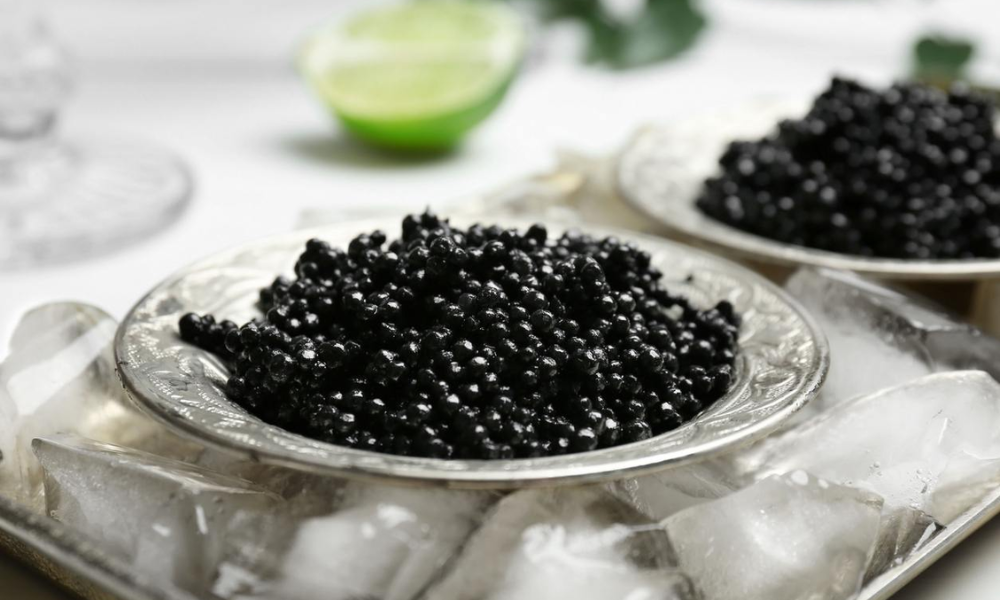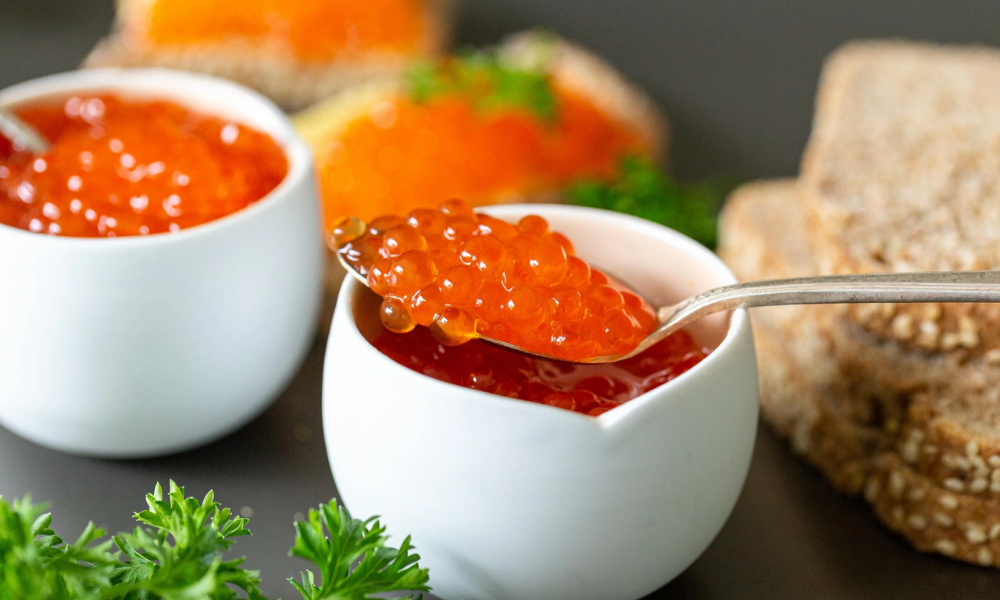Caviar is unfertilized roe or eggs from the sturgeon family of fish, which are enormous, extinct species that are mostly found in the Caspian and Black Sea regions. The eggs are mixed with a dash of salt and allowed to age until they have reached their ideal flavour and texture.
According to Petrossian, its eggs can mature in perfect conditions under close observation for a few weeks to a few months, depending on the species of sturgeon. “During this time, the caviar and salt mix to create complex, nuanced flavours and its renowned texture.
What is Caviar?
Caviar is a luxury food product consisting of salt-cured fish eggs, typically from the sturgeon fish species. The most prized and expensive caviar varieties come from the beluga, osetra, and sevruga sturgeon. However, it can also be sourced from other fish species, such as salmon, trout, and paddlefish, though they are considered less prestigious.
Caviar has a distinct taste and texture. The eggs are typically small and spherical, with a delicate and smooth texture. The flavour can range from mild and buttery to more robust and briny, depending on the type and quality of the caviar. High-quality caviar is often considered a delicacy, prized for its rich flavour and luxurious status.
Traditionally, it is served chilled and eaten directly with a small spoon. It is often accompanied by other items like blinis (small pancakes), toast points, or crème fraîche. It is usually enjoyed as a garnish or topping, adding a luxurious touch to various dishes, such as canapés, sushi, or seafood platters.
It’s important to note that due to overfishing and environmental concerns, wild sturgeon populations have significantly declined, leading to stricter regulations on the production and trade of it. As a result, genuine caviar can be quite expensive and is considered a luxury food item.
What Does Caviar Taste Like?
Caviar has a unique “pop” of texture and a flavour that is saline, salty, and reminiscent of the ocean. The species of sturgeon, the quality of the eggs, and the maturing process all affect flavour nuances.
According to the type of sturgeon and maturation, “the flavours in it can be deep and nuanced, with a range of subtle notes that may include hints of sweetness, earthiness, or even fruitiness,” explains Petrossian.
Five flavours are typical of both caviar and Petrossian:
Oceanic: Some have compared caviar to oysters or fresh seaweed because it is sometimes said to have a mild sea flavour.
Nutty undertone: Ossetra and Kaluga caviar in particular have a nutty undertone. The taste is made more complicated by the nuttiness, which might be subtle or overt.
Buttery: To improve its overall flavour, high-quality caviar frequently has a smooth, buttery, or creamy mouthfeel. For instance, Kaluga and Beluga caviar are renowned for their buttery tastes.
Umami: Caviar has a savoury, umami flavour that many people find to be pleasant since it is high in glutamate.
Rich and complex: Depending on the species and stage of development, there may be faint notes of sweetness, earthiness, or even fruitiness. Petrossian characterises sevruga as having a clean finish and slight minerality, whereas Baika caviar is mildly earthy and nutty with a trace of sweetness and an infinite, lingering finish. He claims that Alverta has a delicate flavour with creamy overtones, while Ossetra caviar fills the senses with a rich, aromatic taste.
How to Eat Caviar?
Eating caviar is a sensory experience that involves savoring its unique flavors and textures. Here are some general guidelines on how to enjoy it:
- Serving temperature: Caviar is best served chilled but not frozen. Keep it refrigerated until you’re ready to serve. Avoid exposing it to excessive heat or direct sunlight, as it can spoil the delicate flavors.
- Utensils: Use a non-metallic spoon to scoop and taste the caviar. Metal utensils can sometimes alter the taste of caviar, so opt for spoons made of materials such as mother of pearl, bone, or plastic.
- Pairings: Caviar is often enjoyed with complementary accompaniments. Traditional options include blinis (small pancakes), toast points, or unsalted crackers. Additionally, you can serve it with crème fraîche, chopped onions, or chives. These accompaniments add texture and enhance the flavor of the caviar.
- Plating: To serve, arrange a small amount of caviar on the spoon or atop the accompaniment of your choice. It’s best to serve caviar in small portions to fully appreciate its nuances.
- Tasting: Place the spoon or accompaniment with caviar in your mouth and allow the eggs to roll over your tongue. Savor the creamy texture and taste the subtle brininess or buttery notes, depending on the caviar variety.
- Enjoyment: Take your time to appreciate the flavors and textures of the caviar. Allow it to linger in your mouth before swallowing to fully experience its nuances.
Is Caviar Healthy?
Caviar is a unique and flavorful food, but its health benefits and drawbacks should be considered. On the positive side, caviar is rich in various nutrients. It is a good source of high-quality proteins, omega-3 fatty acids, vitamins (such as vitamin A, vitamin D, and vitamin B12), and minerals (such as iron, magnesium, and selenium).
However, it’s important to note that it is also high in salt (sodium) due to the curing process. Excessive sodium intake can contribute to high blood pressure and other health issues, especially for individuals with hypertension or kidney problems. Therefore, moderation is key when consuming it.
Another consideration is the potential presence of heavy metals and pollutants in it. Sturgeon, the primary source of it, can accumulate toxins such as mercury and PCBs in their eggs. To minimize exposure, it is advisable to choose caviar from reputable sources that follow strict quality control and testing procedures.
It is a high-calorie food due to its fat content. While the omega-3 fatty acids in it are beneficial, it’s important to be mindful of portion sizes to avoid excessive calorie intake. Ultimately, it can be a part of a balanced diet when consumed in moderation. However, it may not be suitable for everyone, especially those with specific dietary restrictions, allergies, or health conditions.
Can Pregnant Women Consume Caviar?
Pregnant women should exercise caution when it comes to consuming it. While it can provide certain nutritional benefits, there are some considerations to keep in mind.
The primary concern with its consumption during pregnancy is the potential presence of bacteria or parasites that may be present in raw or undercooked fish eggs. Raw or improperly handled caviar can pose a risk of foodborne illnesses such as salmonella or listeria, which can be harmful to both the pregnant woman and the developing fetus.
To minimize the risk, pregnant women are generally advised to opt for pasteurized caviar. Pasteurization involves applying heat to it to kill harmful bacteria and parasites, making it safer for consumption. It is important to carefully read the product labels or inquire about the pasteurization process when purchasing caviar.
Furthermore, pregnant women should be mindful of their overall mercury intake. Some types of fish, including certain species of sturgeon used for its production, can contain higher levels of mercury.
High levels of mercury can be harmful to the developing nervous system of the fetus. They can provide recommendations and help you make informed decisions regarding the consumption of it and other foods during pregnancy.
Are there any Side Effects of Caviar?
Caviar is generally considered safe for consumption, but there are a few potential side effects or considerations to keep in mind:
- Allergic reactions: Some individuals may be allergic to fish or fish products, including caviar. Allergic reactions can range from mild symptoms like itching or hives to more severe reactions such as difficulty breathing or anaphylaxis. If you have a known allergy to fish, it is important to avoid it.
- High sodium content: It is typically cured with salt, which contributes to its distinct flavour. However, this also means that it can be high in sodium. Excessive sodium intake can lead to increased blood pressure, water retention, and other health issues, particularly for individuals with hypertension or kidney problems. Moderation is key when consuming caviar to manage sodium intake.
- Heavy metal contamination: Sturgeon, the primary source, it can accumulate heavy metals such as mercury and PCBs. These contaminants can be present in the fish eggs and may pose health risks if consumed in large quantities. To minimize exposure, it is advisable to choose it from reputable sources that follow strict quality control measures and testing procedures.
- Cost and sustainability concerns: It is considered a luxury food item and can be quite expensive. Additionally, overfishing and illegal harvesting have threatened sturgeon populations and the sustainability of their production. When purchasing, it is important to choose sustainably sourced options and support responsible fishing practices.
Conclusion
In conclusion, it is a highly prized and luxurious food product made from salt-cured fish eggs, primarily sourced from sturgeon species. It is known for its delicate texture and unique flavor, ranging from mild and buttery to robust and briny. It is traditionally served chilled and enjoyed as a garnish or topping on various dishes.
However, due to declining sturgeon populations and environmental concerns, genuine caviar can be quite expensive and is subject to strict regulations. Despite its exclusivity, it remains a sought-after delicacy, appreciated for its luxurious status and rich flavor.



